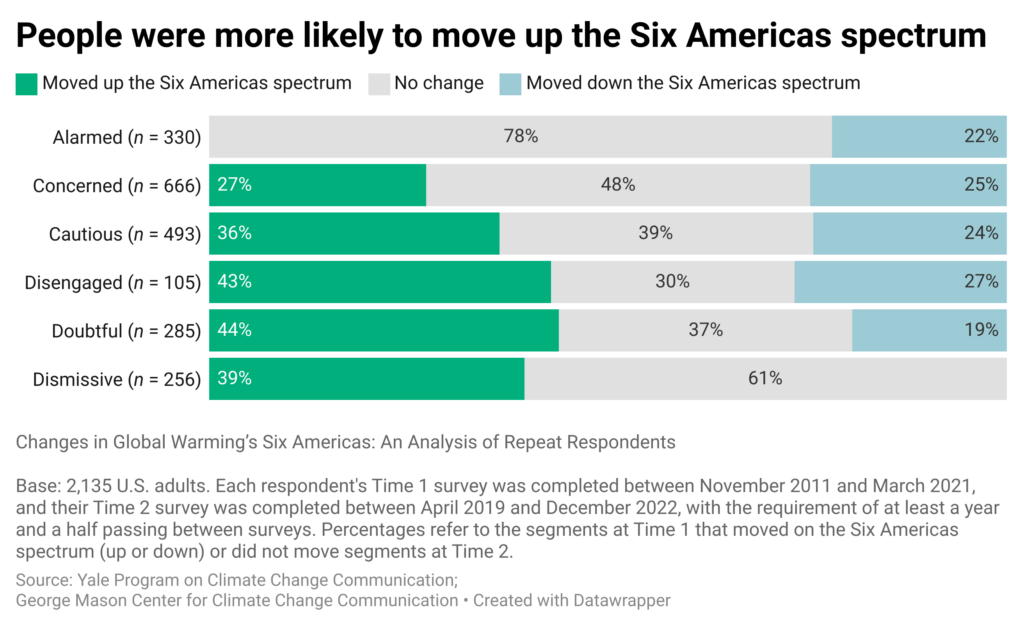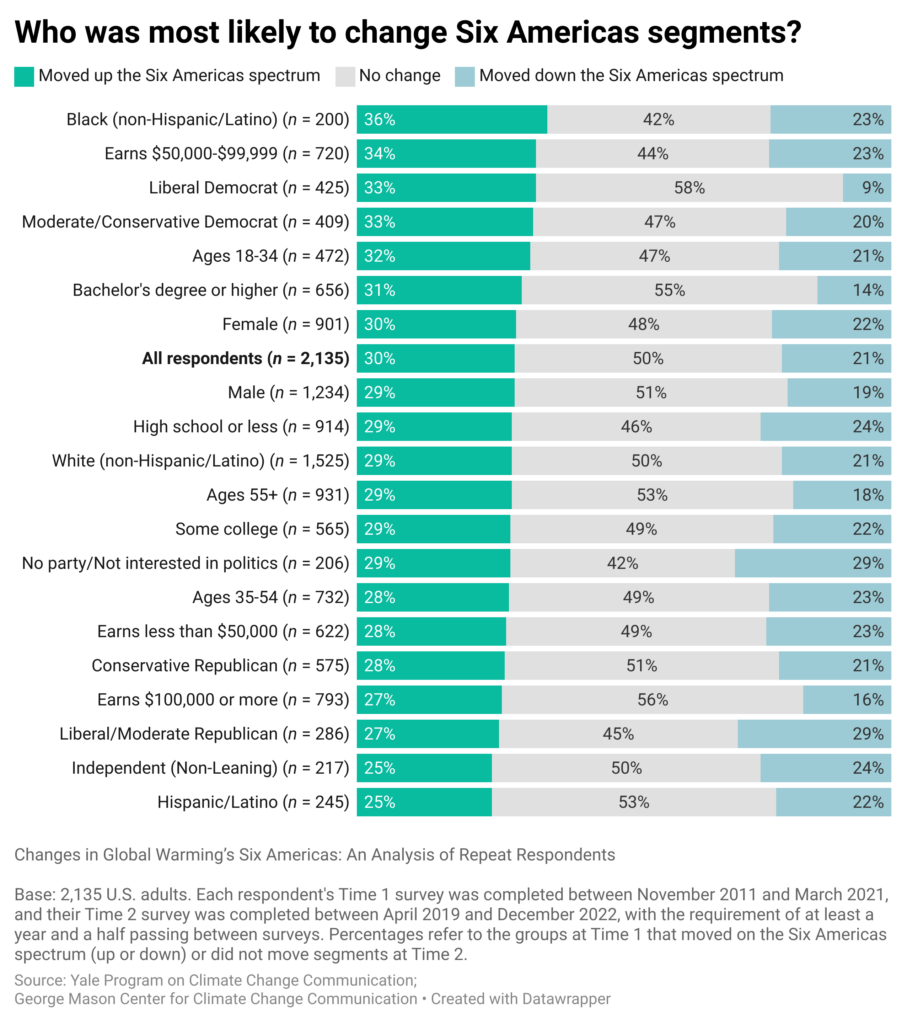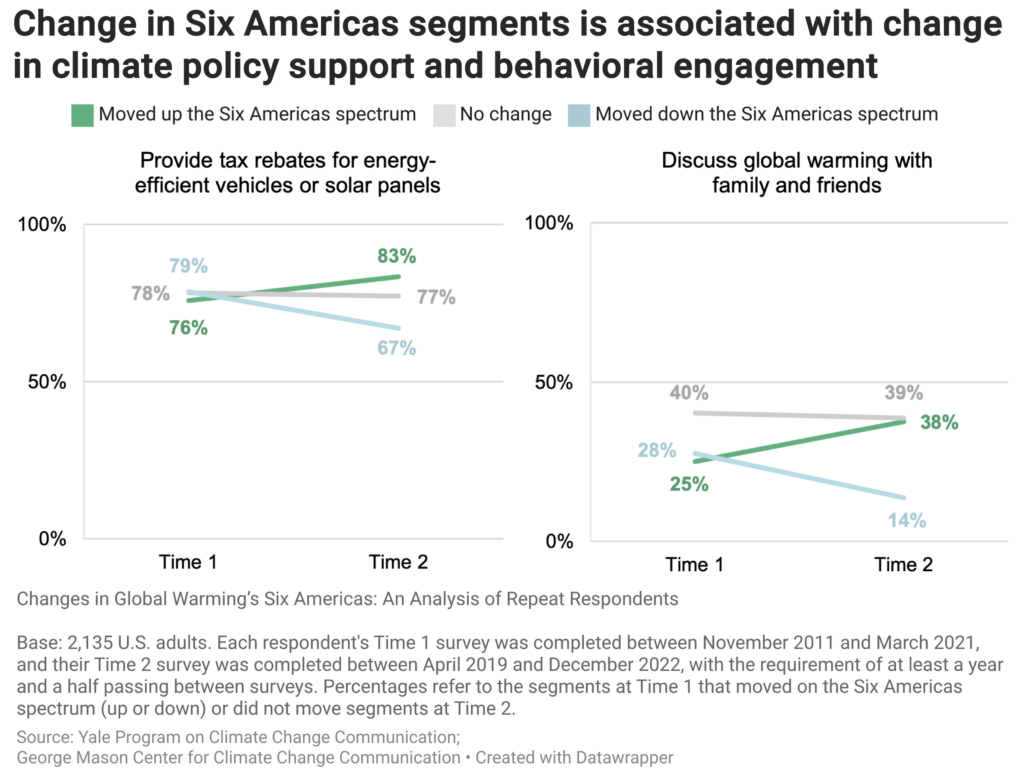Peer-Reviewed Article · Jul 11, 2024
Changes in Global Warming’s Six Americas: An analysis of repeat respondents
By Megan Ayers, Jennifer Marlon, Matthew Ballew, Edward Maibach, Seth Rosenthal, Connie Roser-Renouf and Anthony Leiserowitz
Filed under: Audiences, Behaviors & Actions, Beliefs & Attitudes and Policy & Politics

We are pleased to announce the publication of a new article, “Changes in Global Warming’s Six Americas: An analysis of repeat respondents” in the journal Climatic Change.
The Global Warming’s Six Americas framework describes six climate change audiences within the American public: the Alarmed, Concerned, Cautious, Disengaged, Doubtful, and Dismissive. These groups form a spectrum from most to least worried about global warming. The Alarmed are convinced global warming is happening and human-caused, view it as an immediate threat, and strongly support climate action. At the other end of the spectrum, the Dismissive are convinced that global warming is not happening or human-caused, minimize the risks, and oppose climate action.
People can become more or less worried about and engaged with global warming over time, and thereby switch categories in the Six Americas framework. Our national research has found that the Alarmed have grown more than any other audience, nearly doubling in size over the past decade. However, this prior research used cross-sectional data, or different samples of U.S. adults. Longitudinal data that is collected from the same individuals over time (i.e., panel data) provides evidence about changes among specific people; that is, who has or hasn’t changed their minds about global warming.
In this study, we use panel data to investigate a special cohort of U.S. adults (n = 2,135) who participated in our Climate Change in the American Mind surveys two or more times between 2011 and 2022. We use this panel of “repeaters” and the Six Americas Survey (SASSY) to assess how individuals’ Six Americas status changed over time and who moved up or down the Six Americas spectrum.
Which Six Americas segments moved up or down the spectrum?
Overall, 30% of respondents shifted toward the Alarmed, while 21% shifted toward the Dismissive. The Dismissive were more likely than the Alarmed to change segments over time (39% of the Dismissive moved up the Six Americas spectrum, while 22% of the Alarmed moved down). Additionally, the Doubtful and Disengaged were also more likely to move up the spectrum than down (44% of the Doubtful and 43% of the Disengaged moved up, while 19% and 27%, respectively, moved down). The most common change over time was a shift upwards of one segment. For instance, most of the respondents who became Alarmed were initially Concerned, and most who became Concerned were initially Cautious. Overall, these results show that Americans have become more worried about and engaged with global warming over time.
Who changed Six Americas segments over time?
The demographic and political groups that were most likely to move up the Six Americas spectrum include Black respondents (36% moved up), respondents who earn $50,000-$99,999 in annual household income (34%), liberal Democrats (33%), and moderate/conservative Democrats (33%). Conversely, the groups that were most likely to move down the Six Americas spectrum over time included those who did not identify with a party or were not interested in politics (29% moved down), liberal/moderate Republicans (29%), and Independents (24%).
Are changes in the Six Americas associated with changes in support for climate policy and behavioral engagement?
Respondents who moved up the Six Americas spectrum became more supportive of climate policy, while those who moved down the spectrum became less supportive. Similarly, those who moved up the spectrum became more personally engaged with global warming, while those who moved down the spectrum became less engaged.
These results show that Americans’ climate opinions are dynamic and some people are indeed changing their minds about global warming. This supports our prior research finding that Americans are reporting stronger pro-climate opinions over time. Shifts in public opinion are also evident in the Yale Climate Opinion Maps (YCOM) and Climate Change in the American Mind (CCAM) Explorer. As shown here, Americans are moving up the Six Americas spectrum toward the Alarmed, and these shifts are associated with changes in support for climate policy and behavior. These findings provide further evidence of a growing social consensus that is more closely aligned with the scientific consensus about human-caused climate change – that it is real and a serious threat.
Research indicates there are several important drivers of shifts in public opinion about climate change, including media coverage, cues from elites and political leaders, experience with climate change, and hearing others talk about it (e.g., weathercasters). Public communication can further engage audiences that are more worried about it and motivated to act, as well as those who are less worried or engaged.
The full article is available here, which includes more detail on the findings and methods. If you would like to request a copy of the published paper, please send an email to climatechange@yale.edu with the subject line: Request Repeaters Paper.


